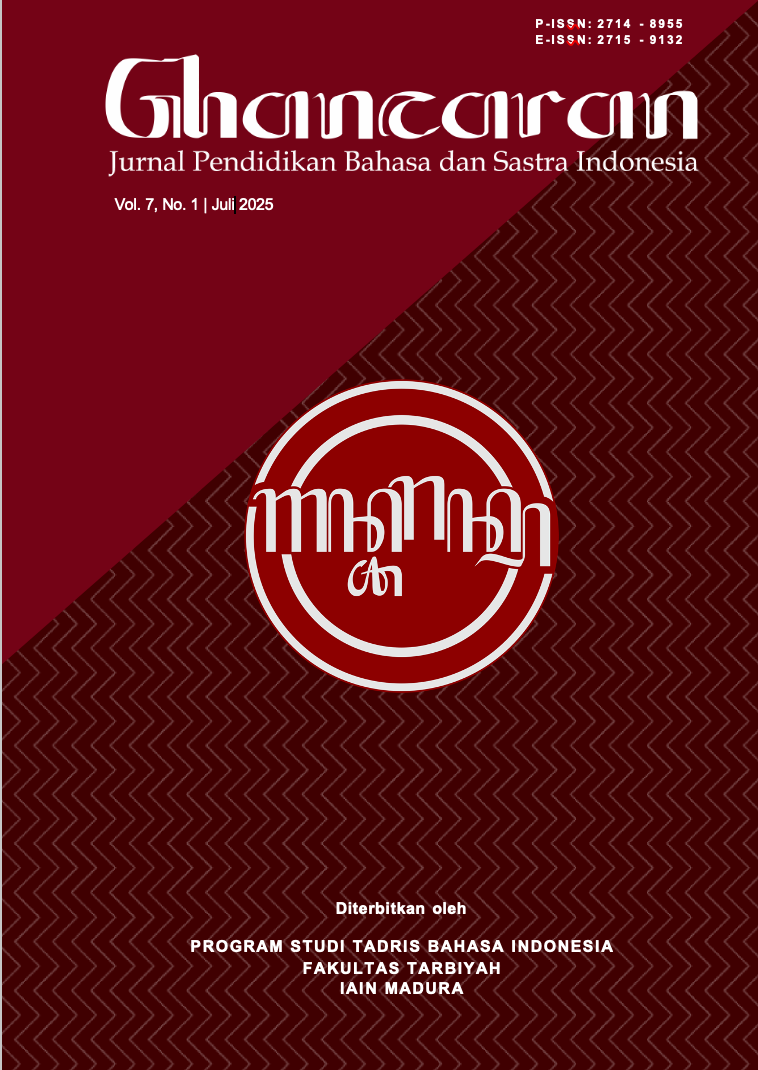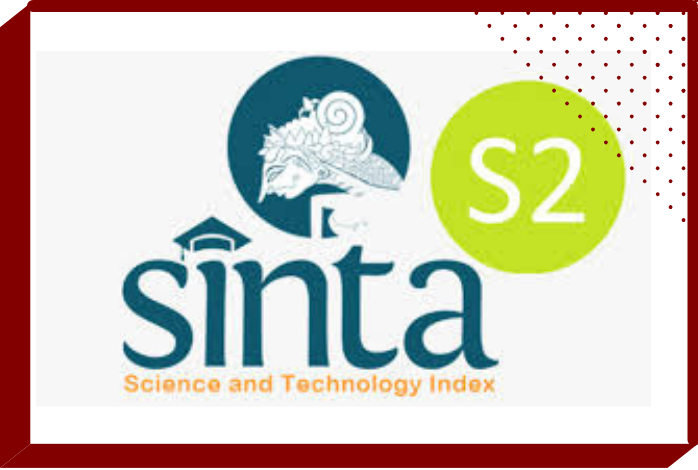Fenomena Post-Trauma Stress Disorder dalam Novel-Novel Karya Ziggy Zezsyazeoviennazabrizkie
 Abstract views: 293
,
Abstract views: 293
,
 PDF downloads: 238
PDF downloads: 238
Abstract
The phenomenon of Post-Traumatic Stress Disorder (PTSD) in the novels of Ziggy Zezsyazeoviennazabrizkie represents a research area that can realistically depict a person's psychological condition. This study aims to describe the types of trauma, causal factors, and literary functions through a psychological literary analysis using a qualitative descriptive method, focusing on the novels di Tanah Lada, White Wedding, and San Francisco by Ziggy Zezsyazeoviennazabrizkie. The findings of this research indicate that the three protagonists from the three different novels are identified as experiencing PTSD trauma, caused by two factors: psychosocial and sociocultural. Furthermore, the study reveals the literary functions of story development, character development, and event creation. PTSD trauma is marked by exposure to painful or stressful events, the presence of intrusive symptoms following the traumatic events, continuous avoidance of stimuli related to the traumatic experience, and other related symptoms. Psychosocial causal factors include parental deprivation and a pathogenic family structure, while sociocultural factors involve social roles and social changes. The literary functions within the novels include story development, character development, and event creation. These three key themes show that the three different novels by the same author are interconnected, reflecting the psychological abnormalities of PTSD in the lives of the characters.
Downloads
References
Aulia, B. (2020). Trauma Kejiwaan Tokoh Utama dalam Novel Lelaki Harimau Karya Eka Kurniawan. Jurnal Bindo Sastra, 4(1), 29-37.
Ayuningtyas, D., & Rayhani, M. (2018). Analisis Situasi Kesehatan Mental Pada Masyarakat di Indonesia dan Strategi Penanggulangannya. Jurnal Ilmu Kesehatan Masyarakat, 9(1), 1-10.
Basuki, N. V. A., & Mulyono, M. (2018). Pengaruh Pelecehan Seksual Terhadap Pembentukan Perilaku Transgender pada Tokoh Sasana dalam Novel Pasung Jiwa Karya Okky Madasari: Kajian Psikologi Sastra. Jurnal Sastra Indonesia, 7(2), 95-100.
Cardoso, G., Antunes, A., Silva, M., Azeredo-Lopes, S., Xavier, M., Koenen, K., & Caldas-de-Almeida, J. M. (2020). Trauma Exposure and PTSD In Portugal: Findings from the World Mental Health Survey Initiative. Psychiatry Research, 284, 112644.
Dominique, J. F., & Margraf, J. (2008). Glucocorticoids for The Treatment of Post-Traumatic Stress Disorder and Phobias: A Novel Therapeutic Approach. European Journal of Pharmacology, 583(2-3), 365-371.
Davison, G. C., John M. N., dan Ann M. K. (2006). Psikologi Abnormal: Edisi ke-9. Jakarta: PT Raja Grafindo Persada.
Endraswara, S. (2013). Metodologi Penelitian Sastra. Yogyakarta: Media Pressindo.
Ernawati, M., Suwignyo, H., & Roekhan, R. (2018). Kecenderungan Penokohan dan Pengaluran Cerpen Karya Mahasiswa UM dalam Majalah Komunikasi Tahun Terbit 2011-2017. BASINDO: Jurnal Kajian Bahasa, Sastra Indonesia, dan Pembelajarannya, 2(1), 29–37.
Gorska, E. (2016). Memory Activism: Methods of Creation of Alternative Collective Memory in Former Yoguslavia and Israel. Maska. (32), 7-19.
Hooley, James N. B., Matthew K. N., dan Susan, M. 2018. Psikologi Abnormal. Jakarta: Salemba Hamanika.
Kramutally, H. 2017. Latency, Flashback and Resilience in Amit Majmudar’s Partitions and Jennifer Bradbury’s a Moment Comes. Tesis tidak diterbitkan. Selangor: Universiti Putra Malaysia.
Kurnia, I. A. 2018. Penggambaran Trauma Arima Kousei dalam Anime Your Lie in April Menggunakan Metode Analitik. Jurnal: Janaru Saja, 7(1), 8-19.
Lincolin, T. M., Martin, N., Jaya, E. S. (2016). Childhood Trauma and Psychotic Experince in a General Population Sample: a Prosective Study on the Mediating Role of Emotion. European Psychiatry, 42, 111-119.
Marthoenis, Aichberger, Ocak. S. (2016). Mental Health in Aceh-Indonesia: A Decade After the Devastating Tsunami 2004, Asian Journal of Psychiatry, 19, 59-65.
Margaretha, M., Nuringtyas, R., & Rachim, R. (2013). Childhood Trauma of Domestic Violence and Violence in Further Intimate Relationship. Makara Human Behavior Studies in Asia, 17(1), 33-42.
Moni, Y. G., Nama, I. K., Jumadiah, S. (2017). Novel Bapak, Kapan Kita Akan Berdamai? Karya Regza Sajogur: Kajian Psikologi Sastra. Jurnal Humanis, 21(1), 66-70.
Puspita, M. D., Khoiri, M. (2017). People's Trauma in Pre-French Revolution Era Victor Hugo's Les Miserable. Journal Litera Cultura, 5(3), 81-90.
Ridha, N. A., Anshari, dan Juanda. (2019). Abnormalitas Tokoh Gadis dalam Novel Androphobia Karya Ullan Pralihanta (Tinjauan Psikologi Sastra). Jurnal: Retorika, 8(1), 1-15,
Supratiknya. (1995). Mengenal Perilaku Abnormal. Yogyakarta: Kanisus (Anggota IKAPI).
Schiraldi, G. R. (2009). The Post-Traumatic Stress Disorder. New York: Mc Grow-Hill.
Syafridon, Nurizzati, Nasution, B. (2014). Kekerasaan Terhadap Anak dalam Rumah Tangga dalam Novel Pintu Terlarang Karya Sekar Ayu Asmara. Jurnal: Bahasa dan Sastra, 2(2), 55-68.
Thormar, S. B., Gersonb, B. P. R., Juen, B., Djakababad, M. N., Karlsson. T., Olff, M. (2014). The Impact of Disaster Work on Community Volunteers: The Role of Peri- Traumatic Distress, Level of Personal Affectedness, Sleep Quality and Resource Loss, on Post-Traumatic Stress Disorder Symptoms and Subjective Health. Journal of Anxiety Disourders, 28(8), 971-977.
Vasantadjaja, L. (2017). Trauma dalam Novel Yu Zhen. Jurnal: Lite (Bahasa, Sastra, dan Budaya), 13(1), 19-37.
Yatham, S., Sivathasan, S., Yoon, R., da Silva, T. L., & Ravindran, A. V. (2018). Depression, Anxiety, and Post-traumatic Stress Disorder Among Youth in Low and Middle Income Countries: A Review of Prevalence and Treatment Interventions. Asian Journal of Psychiatry, 38, 78–91.
Zezsyazeoviennazabrizkie, Z. (2015). Di Tanah Lada. Jakarta: Gramedia.
Zezsyazeoviennazabrizkie, Z. (2015). White Wedding. Bandung: Pastel Books.
Zezsyazeoviennazabrizkie, Z. (2016). San Fransisco. Jakarta: Gramedia.
Copyright (c) 2025 GHANCARAN: Jurnal Pendidikan Bahasa dan Sastra Indonesia

This work is licensed under a Creative Commons Attribution-ShareAlike 4.0 International License.
Ghancaran: Jurnal Pendidikan Bahasa dan Sastra Indonesia uses an Open Access Policy under the Creative Commons Attribution-ShareAlike 4.0 International License. Authors publishing in this journal agree to the following terms:
- Ghancaran Journal holds the copyright and grants the journal rights for first publication with the work simultaneously licensed under a

The work is distributed under Creative Commons Attribution-ShareAlike 4.0 International License which allows others to share, copy, and redistribute the material in any media or format and adapt, remix, change, and develop the material even for commercial purposes, as long as it is stated credit and license derivative works under similar terms. - Authors may make additional contractual arrangements for non-exclusive distribution of the journal's published work version.
- Authors are permitted to post their work online (e.g., in institutional repositories or on their websites) before and during submission, as doing so may lead to productive exchange.



















